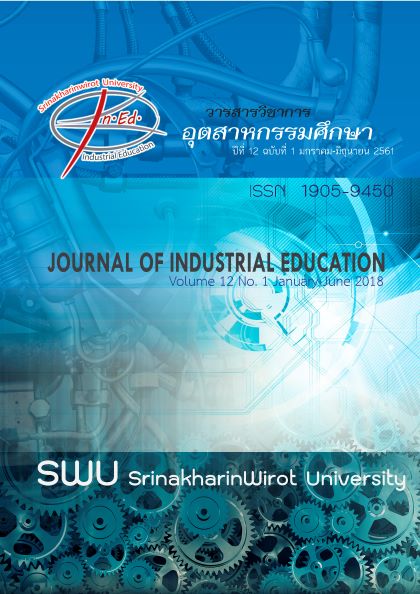การศึกษาปริมาณการเกิดเชื้อราของเมล็ดชาน้ำมันในกระบวนการตากแดด ตามธรรมชาติและการอบแห้งในตู้อบ
Abstract
การศึกษาปริมาณการเกิดเชื้อราของเมล็ดชาน้ำมันในกระบวนการตากแดด ตามธรรมชาติและการอบแห้งในตู้อบ ไพโรจน์ ด้วงนคร คณะเทคโนโลยีอุตสาหกรรม มหาวิทยาลัยราชภัฏเชียงราย บทคัดย่อ งานวิจัยในครั้งนี้เป็นการศึกษาผลของกระบวนการอบแห้งต่อปริมาณการเกิดเชื้อราของเมล็ดชาน้ำมัน และระยะเวลาการอบแห้งที่เหมาะสม โดยใช้กระบวนการอบแห้งเมล็ดชาน้ำมันที่แตกต่างกัน 4 กระบวนการ คือ ตากแดดตามธรรมชาติ เป็นวลา 3 วัน (S1), ตากแดดตามธรรมชาติ เป็นวลา 7 วัน (S2), อบด้วยตู้อบที่อุณหภูมิ 69 องศาเซลเซียส เป็นเวลา 3 วัน (O1) และอบด้วยตู้อบที่อุณหภูมิ 69 องศาเซลเซียส เป็นเวลา 7 วัน (O2) ผลการวิจัยพบว่า เมล็ดชาน้ำมันที่ผ่านกระบวนการตากแดดด้วยวิธีการตามธรรมชาติ เป็นเวลา 3 วัน (S1)มีปริมาณความชื้น เท่ากับ 24.41 % และปริมาณเชื้อรา เท่ากับ 1.1 x 103 CFU/g เมื่อตากแดดเมล็ดชาน้ำมันครบ 7 วัน (S2) พบว่า มีปริมาณความชื้น เท่ากับ 18.63 % และปริมาณเชื้อรา เท่ากับ 4.6 x 102 CFU/g และการอบด้วยตู้อบเป็นเวลา 3 วัน (O1) พบว่ามีปริมาณความชื้น เท่ากับ 16 % และปริมาณเชื้อรา เท่ากับ 1.2 x 102 CFU/g เมื่ออบเมล็ดชาน้ำมัน 7 วัน (O2) มีปริมาณความชื้น เท่ากับ 10.75 % และปริมาณการเกิดเชื้อราเท่ากับ< 10 CFU/gดังนั้นจะเห็นได้ว่ากระบวนการอบแห้งที่อุณหภูมิสูงขึ้น และระยะเวลาในการอบแห้งที่เพิ่มขึ้น ส่งผลต่อปริมาณความชื้น และปริมาณเชื้อราให้ลดลงอย่างมีนัยสำคัญทางสถิติ (P≤0.05) ดังนั้นการอบเมล็ดชาน้ำมันด้วยตู้อบที่อุณหภูมิ 69 องศาเซลเซียส เป็นเวลา 7 วัน (O2) เป็นสภาวะที่มีความเหมาะสมมากที่สุด เนื่องจากเมล็ดชาน้ำมันที่อบด้วยสภาวะนี้มีปริมาณความชื้น (10.75 %) และมีปริมาณการเกิดเชื้อราน้อยที่สุด (< 10 CFU/g)ซึ่งปริมาณความชื้นที่ต่ำกว่า 14% สามารถยับยั้งการเจริญเติบโตของเชื้อราได้ คำสำคัญ:เมล็ดชาน้ำมัน การตากแดด การอบแห้ง ปริมาณการเกิดเชื้อรา The Study On Quantity Of Fungus In Dried Tea Oil Seeds Using Oven In Comparison With Sun Dried Process Pairoj Duangnakhon Faculty of Industrial Technology, Chiang Rai Rajabhat University Abstract The purposes of this study were to examine theeffect of drying process on the amount of fungus in teaoil seeds, and to investigate theappropriate period of drying tea oil seeds. The drying processes used different methods, that is, S1using natural sun drying for 3 days, S2 using natural sun drying for 7 days, O1using oven drying at the temperature of 69 degree Celsius for 3 days andO2 using oven drying at the temperature of 69 degree Celsius for 7 days. The experimental results indicated that the S1, S2 and O1 drying methods provide moisture content of 24.41%, 18.63%, 16%, with the amount of fungus at 1.1×103, 4.6×102 and 1.2×102 CFU/g respectively. While the O2 drying method gives moisture contents of 10.75% with the amount of fungus less than 10 CFU/g. It could be seen that the amount of fungus is relevant to the moisture content; therefore, the prolonged oven drying time could significantly reduce the emerging of fungus and moisture content (P≤0.05). Since the moisture content lower than 14% is required in order to control the emerging fungus in tea oil seeds, the results also confirmed that using oven drying at 69 degree Celsius for 7 days (O2) is the appropriate method due to it only gives moisture contents of 10.75% with the lowest amount of fungus (< 10 CFU/g). Keywords: Tea oil seeds, Sun drying, Oven drying, Amount of fungusDownloads
Download data is not yet available.
Downloads
Issue
Section
บทความวิจัย







